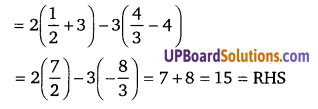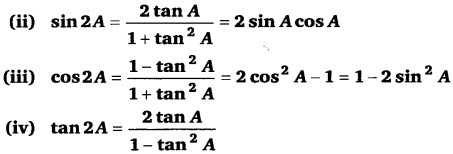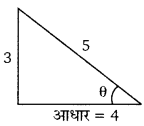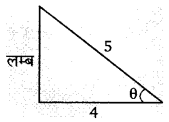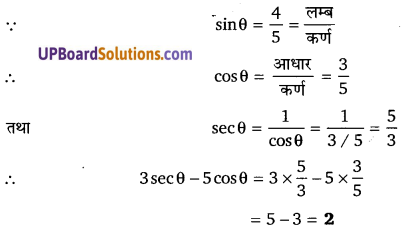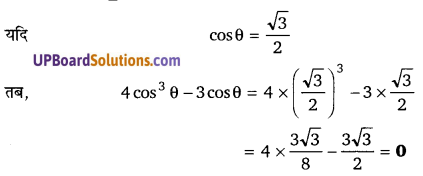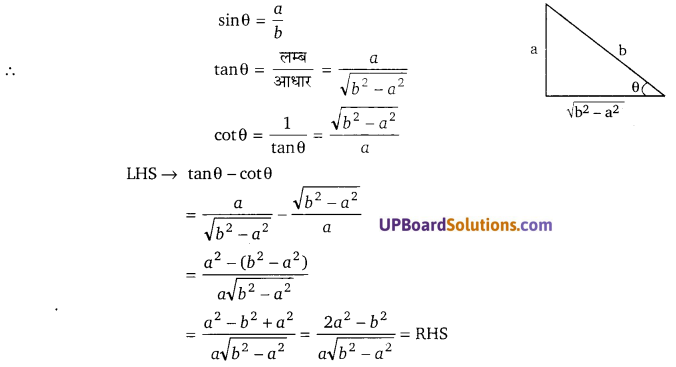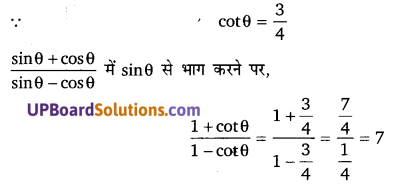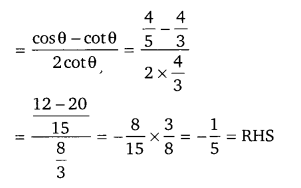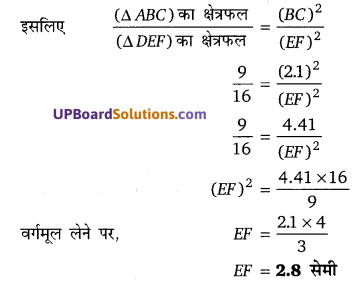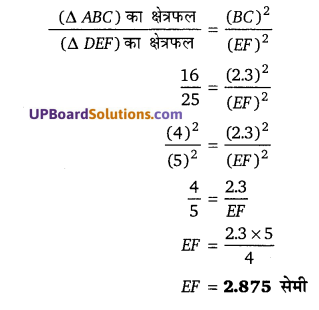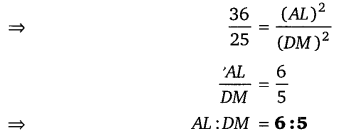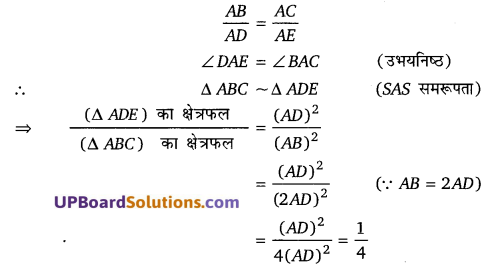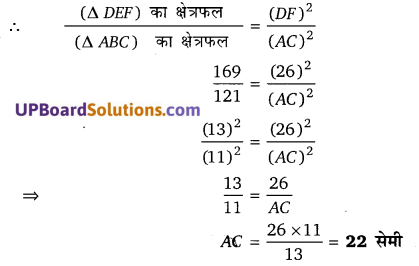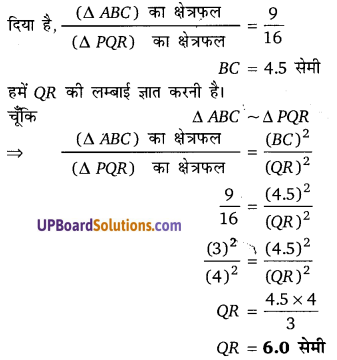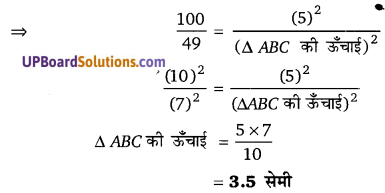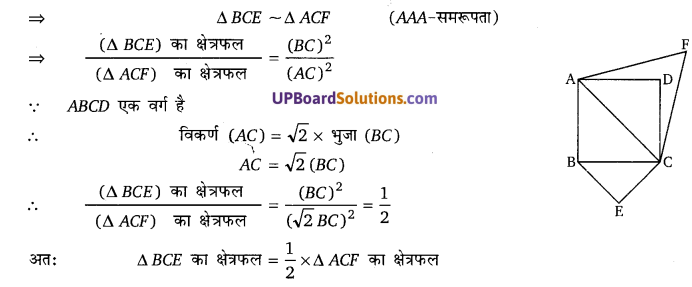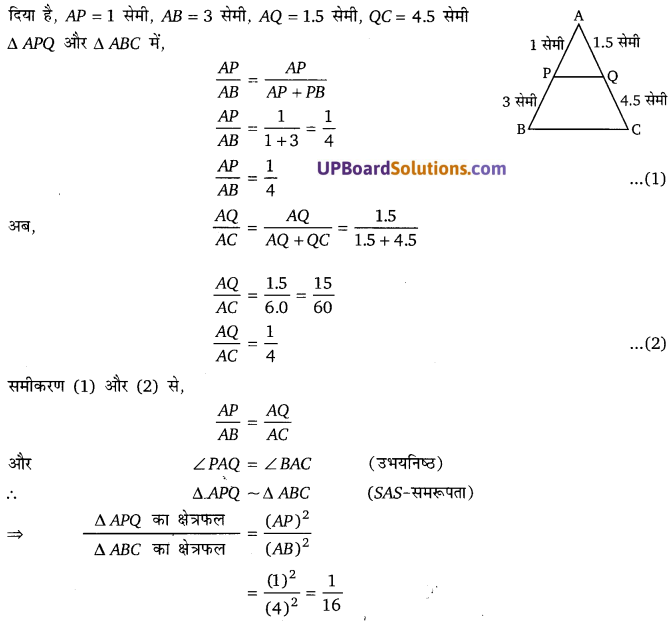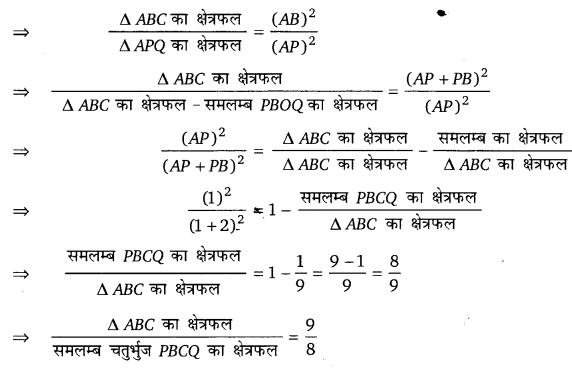Balaji Class 10 Maths Solutions Chapter 4 Quadratic Equations Ex 4.4 द्विघात समीकरण
प्रश्न 1.
k का वह मान ज्ञात कीजिए, जिसके लिए (UPBoardSolutions.com) समीकरण x2 – 4x + k = 0 के मूल वास्तविक और भिन्न
हलः
x2 – 4x + k = 0
यहाँ a = 1, b = – 4, c = k
∵ समीकरण के मूल वास्तविक और भिन्न हैं
∴ विविक्तकर, D > 0
या b2 – 4ac > 0
( – 4)2 – 4 × 1 × k > 0
16 – 4k > 0
16 > 4k या [latex]\frac{16}{4}[/latex] > k
k < 4

प्रश्न 2.
यदि P, q और r वास्तविक हैं तथा p ≠ q तब सिद्ध (UPBoardSolutions.com) कीजिए कि समीकरण (p – q)x2 + 5(p + q)x – 2(p – q) = 0 के मूल वास्तविक और असमान हैं।
हलः
समीकरण (p – q)x2 + 5(p + q)x – 2(p – q) = 0
विविक्तकर, D = b2 – 4ac
= {5 (p + q)}2 – 4(p – q) × – 2(p – q)
= 25 (p2 + q2 + 2pq) + 8(p – q)2
= 25p22+ 25q2 + 50 pq + 8(p2 + q2 – 2pq)
= 25p2 + 25q2 + 50pq + 8p2 + 8q2 – 16pq
= 33p2 + 33q2 + 34pq
∵ D > 0
∴ दी गई समीकरण के मूल वास्तविक और असमान हैं। इति सिद्धम्।
प्रश्न 3.
k का मान ज्ञात कीजिए जिसके लिए समीकरण x2 + 5kx + 16 = 0 के मूल वास्तविक नहीं हैं।
हलः
x2 + 5kx + 16 = 0
यहाँ a = 1, b = 5k, c = 16
∵ समीकरण के मूल वास्तविक नहीं हैं
∴ b2 – 4ac < 0
(5k)2 – 4 × 1 × 16 < 0
25k2 – 64 < 0
k2 < [latex]\frac{64}{25}[/latex] k < [latex]\sqrt{\frac{64}{25}}[/latex]
या k < [latex]\pm \frac{8}{5}[/latex]
या -[latex]\frac{8}{5}[/latex] < k < [latex]\frac{8}{5}[/latex] [∵ x2 – a < 0 ⇒ – a < x < a]

प्रश्न 4.
k के किस मान के लिए, (4 – k)x2 + (2k + 4)x + (8k + 1) = 0 पूर्ण वर्ग है?
हलः
(4 – k)x2 + (2k + 4)x + (8k + 1) = 0
यहाँ a = (4 – k), b = (2k + 4), c = (8k + 1)
∵ मूल पूर्ण वर्ग हैं।
∴ b2 – 4ac > 0
(2k + 4)2 – 4(4 – k)(8k + 1) > 0
4k2 + 16 + 16k – 4(32k + 4 – 8k2 – k) > 0 (UPBoardSolutions.com)
4k2 + 16 + 16k – 4( – 8k2 + 31k + 4) > 0
4[k2 + 4 + 4k + 8k2 – 31k – 4] > 0
9k2 – 27k > 0
9k(k – 3) > 0
जब 9k > 0 तब k > 0
जब k – 3 > 0 तब k > 3
प्रश्न 5.
k का वह मान ज्ञात कीजिए जिसके लिए समीकरण x2 + k(2x + k – 1) + 2 = 0 के मूल वास्तविक और बराबर हैं।
हलः
समीकरण x2 + k (2x + k – 1) + 2 = 0
x2 + 2kx + k2 – k + 2 = 0
यहाँ a = 1, b = 2k, c = k2 – k + 2
∵ समीकरण के मूल वास्तविक और बराबर हैं।
∴ b2 – 4ac = 0
(2k)2 – 4 × 1 × (k2 – k + 2) = 0
4k2 – 4k2 + 4k – 8 = 0
4k – 8 = 0
k = [latex]\frac{8}{4}[/latex] ⇒ k = 2

प्रश्न 6.
निम्नलिखित प्रत्येक में k का मान ज्ञात कीजिए (UPBoardSolutions.com) जिसके लिए निम्न समीकरण के मूल वास्तविक और बराबर हैं।
(i) x2 – 2(k + 1)x + k2 = 0
(ii) k2x2 – 2(2k – 1)x + 4 = 0
(iii) (k + 1)x2 – 2(k – 1)x + 1 = 0
(iv) kx(x – 2) + 6 = 0 (NCERT)
(v) x2 – 4kx + k = 0
हलः
(i) x2 – 2(k + 1)x + k2 = 0
यहाँ a = 1, b = – 2(k + 1), c = k2
∵ समीकरण के मूल वास्तविक और बराबर हैं।
∴ b2 – 4ac = 0
[- 2(k + 1)]2 – 4 × 1 × k2 = 0
4(k + 1)2 – 4k2 = 0
4 (k2 + 1 + 2k – k2) = 0
1 + 2k = 0 या k= [latex]-\frac{1}{2}[/latex]
(ii) k2x2 – 2(2k – 1)x + 4 = 0
यहाँ a = k2, b = – 2(2k – 1), c = 4
∵ समीकरण के मूल वास्तविक (UPBoardSolutions.com) और बराबर हैं।
∴ b2 – 4ac = 0
[- 2(2k – 1)]2 – 4 × k2 × 4 = 0
4(2k – 1)2 – 16k2 = 0
4[(2k – 1)2 – 4k2] = 0
4k2 + 1 – 4k – 4k2 = 0
1 – 4k = 0 या 1 = 4k
k = [latex]\frac{1}{4}[/latex]
(iii) (k + 1)x2 – 2(k – 1)x + 1 = 0
यहाँ a = (k + 1), b = – 2(k – 1), c = 1
∵ समीकरण के मूल वास्तविक और बराबर हैं।
∴ b2 – 4ac = 0
[- 2(k – 1)]2 – 4 × (k + 1) × 1 = 0
4 (k – 1)2 – 4(k + 1) = 0
4[(k – 1)2 – (k + 1)] = 0
k2 + 1 – 2k – k – 1 = 0
k2 – 3k = 0 या k(k – 3) = 0
∴ k = 0 तथा k – 3 = 0 या k = 3
अत: k = 0, 3
(iv) kx(x – 2) + 6 = 0
या kx2 – 2kx + 6 = 0
यहाँ a = k, b = – 2k, c = 6
∵ समीकरण के मूल वास्तविक और बराबर हैं।
∴ b2 – 4ac = 0
(- 2k)2 – 4 × k × 6 = 0
4k2 – 24k = 0
4k (k – 6) = 0
∴ 4k = 0 तथा k – 6 = 0
k = 0 , k = 6
अत: k = 0, 6

(v) x2 – 4kx + k = 0
यहाँ a = 1, b = – 4k, c = k
∵ समीकरण के मूल वास्तविक और बराबर हैं।
∴ b2 – 4ac = 0
(- 4k)2 – 4 × 1 × k = 0
16k2 – 4k = 0
4k (4k – 1) = 0
∴ 4k = 0 तथा 4k – 1 = 0
k = 0, k = [latex]\frac{1}{4}[/latex]
अत:k = 0, [latex]\frac{1}{4}[/latex]
प्रश्न 7.
यदि समीकरण (b – c)x2 + (c – a)x + (a – b) = 0 (UPBoardSolutions.com) के मूल बराबर हैं तब सिद्ध कीजिए कि 2b = a + c अर्थात् a, b और c समान्तर श्रेणी में हैं।
हलः
(b – c)x2 + (c – a)x + (a – b) = 0
यहाँ a = (b – c), b = (c – a), c = (a – b)
∵ समीकरण के मूल बराबर हैं।
∴ b2 – 4ac = 0
(c – a)2 – 4(b – c)(a – b) = 0
c2 + a2 – 2ca – – 4(ab – b2 – ca + bc) = 0
c2 + a2 – 2ca – 4ab + 4b2 + 4ca – 4bc = 0
c2 + a2 + 2ca + 4b2 – 4ab – 4bc = 0
c2 + a2 + (- 2b)2 + 2ca + 2a(- 2b) + 2(- 2b)c = 0
(c + a – 2b)2 = 0
c + a = 2b
या 2b = a + c
अर्थात् a, b और c समान्तर श्रेणी में हैं। इति सिद्धम्।

प्रश्न 8.
k के किस मान के लिए, द्विघात समीकरण (UPBoardSolutions.com) (3k + 1)x2 + 2(k + 1)x + 1 = 0 के मूल बराबर हैं?
हलः
(3k + 1) x2 + 2(k + 1)x + 1 = 0
यहाँ a = (3k + 1), b = 2(k + 1), c = 1
∵ समीकरण के मूल बराबर हैं।
∴ b2 – 4ac = 0
[2(k + 1)]2 – 4(3k + 1) × 1 = 0
4(k + 1)2 – 4(3k + 1) = 0
4 [(k + 1)2 – (3k + 1)] = 0
k2 + 1 + 2k – 3k – 1 = 0
k2 – k = 0
k(k – 1) = 0
तब, k = 0 तथा k – 1 = 0 ⇒ k = 1
अत: k = 0, k = 1
प्रश्न 9.
k का मान ज्ञात कीजिए जिसके लिए द्विघात समीकरण (UPBoardSolutions.com) (k + 1)x2 – 6(k + 1)x + 3(k + 9) = 0, k ≠ – 1 के मूल बराबर हैं तथा मूलों को भी ज्ञात कीजिए।
हलः
(k + 1)x2 – 6(k + 1)x + 3(k + 9) = 0 जहाँ k ≠ – 1
यहाँ a = (k + 1), b = – 6(k + 1), c = 3(k + 9)
∵ समीकरण के मूल बराबर हैं। अतः
∴ b2 – 4ac = 0
[- 6(k + 1)]2 – 4 × (k + 1) × 3 (k + 9) = 0
36(k + 1)2 – 12(k + 1) (k + 9) = 0
12(k + 1)[3 (k + 1) – (k + 9)] = 0
(k + 1)(3k + 3 – k – 9) = 0
(k + 1)(2k – 6) = 0
अतः 2k – 6 = 0 (∵ k≠ – 1)
या 2k = 6
या k = 3
k का मान समीकरण में रखने पर, (3 + 1)x2 – 6(3 + 1)x + 3(3 + 9) = 0
4x2 – 24x + 3 × 12 = 0
4x2 – 24x + 36 = 0
x2 – 6x + 9 = 0
(x)2 – 2 × 3 × x + (3)2 = 0
(x – 3)2 = 0
अतः x = 3, 3

प्रश्न 10.
यदि – 5, एक द्विघात समीकरण 2x2 + px – 15 = 0 का मूल है और द्विघात समीकरण p(x2 + x) + k = 0 के मूल बराबर हैं, तो k का मान ज्ञात कीजिए।
हलः
द्विघात समीकरण 2x2 + px – 15 = 0 का एक मूल –5 है।
तो x = – 5 रखने पर,
2(- 5)2 + p(- 5) – 15 = 0
या 50 – 5p – 15 = 0
35 – 5p = 0 या 35 = 5p
या [latex]\frac{35}{5}[/latex] = p या p = 7
तथा द्विघात समीकरण p(x2 + x) (UPBoardSolutions.com) + k = 0
∵ p = 7
∴ 7(x2 + x) + k = 0
या 7x2 + 7x + k = 0
यहाँ a = 7, b = 7, c = k
∵ समीकरण के मूल बराबर हैं।
∴ b2 – 4ac = 0
(7)2 – 4 × 7 × k = 0
49 – 28k = 0 या – 28k = – 49
28k = 49 या k = [latex]\frac{49}{28}=\frac{7}{4}[/latex]

प्रश्न 11.
यदि समीकरण (c2 – ab)x2 – 2(a2 – bc)x + b2 – ac = 0 के मूल बराबर हैं तो सिद्ध कीजिए कि a = 0 या a3 + b3 + c3 = 3abc
हलः
समीकरण (c2 – ab)x2 – 2(a2 – bc)x + b2 – ac = 0
A = c2 – ab, B = -2(a2 – bc), C = b2 – ac
∵ समीकरण के मूल बराबर हैं।
∴ (B)2 – 4AC = 0
[- 2(a2 – bc)]2 – 4(c2 – ab)(b2 – ac) = 0
4(a2 – bc)2 – 4(b2c2 – ac3 – ab3 + a2bc) = 0
4(a4 + b2c2 – 2a2bc – b2c2 + ac3 + ab3 – a2bc) = 0
a4 + ab3 + ac3 – 3a2bc = 0
a(a3 + b3 + c3 – 3abc) = 0
a = 0 तथा a3 + b3 + c3 – 3abc = 0
a3 + b3 + c3 = 3abc
अतः a = 0 या a3 + b3 + c3 = 3abc इति सिद्धम्।(UPBoardSolutions.com)
प्रश्न 12.
यदि समीकरण (a + b)x2 – 2(ac + bd) x + (c2 + d2) = 0 के मूल बराबर हैं, तो सिद् कीजिए कि [latex]\frac{a}{b}=\frac{c}{d}[/latex]
हलः
समीकरण (a2 + b2)x2 – 2(ac + bd)x + (c2 + d2) = 0
A = a2 + b2, B = – 2(ac + bd), C = (c2 + d2)
∵ समीकरण के मूल बराबर हैं।
∴ B2 – 4AC = 0
[- 2 (ac + bd)]2 – 4(a2 + b2)(c2 + d2) = 0
4(ac + bd)2 – 4(a2c2 + a2d2 + b2c2 + b2d2)= 0
4[a2c2 + b2d2 + 2acbd – a2c2 – a2d2 – b2c2 – b2d2] = 0
-a2d2 – b2c2 + 2acbd = 0
– [(ad)2 + (bc)2 – 2acbd] = 0
(ad – bc)2 = 0
ad – bc = 0
ad = bc
[latex]\frac{a}{b}=\frac{c}{d}[/latex] इति सिद्धम्।

प्रश्न 13.
यदि द्विघात समीकरण 3x2 + px – 8 = 0 का एक मूल 2 है और(UPBoardSolutions.com) द्विघात समीकरण 4x2 – 2px + k = 0 के मूल बराबर हैं, तो k का मान ज्ञात कीजिए।
हल:
द्विघात समीकरण 3x2 + px – 8 = 0 का एक मूल 2 है।
तो x = 2 रखने पर,
3(2)2 + px2 – 8 = 0
या 3 × 4 + p × 2 – 8 = 0
12 + 2p – 8 = 0
या 4 + 2p = 0
या 2p = – 4 या p = [latex]-\frac{4}{2}[/latex]
p = – 2
तथा द्विघात समीकरण 4x2 – 2px + k = 0 में p = – 2 रखने पर,
∴ 4x2 – 2( – 2)x + k = 0
या 4x2 + 4x + k = 0
यहाँ a = 4, b = 4, c = k
∵ समीकरण के मूल बराबर हैं।
∴ b2 – 4ac = 0
(4)2 – 4 × 4 × k = 0
16 – 16k = 0
या – 16k = – 16
या k = [latex]\frac{16}{16}[/latex] ⇒ k = 1
प्रश्न 14.
यदि समीकरण ax2 + 2bx + c = 0 और bx2 – 2[latex] \sqrt{{ac}} [/latex] x + b = 0 के मूल साथ – साथ वास्तविक हैं तो सिद्ध कीजिए कि b2 = ac अर्थात् a, b, c गुणोत्तर श्रेणी में हैं।
हलः
यदि समीकरण ax2 + 2bx + c = 0 और bx2 – 2[latex] \sqrt{{ac}} [/latex]x + b = 0 के मूल वास्तविक हैं।
(2b)2 – 4ac = (- 2[latex] \sqrt{{ac}} [/latex])2 – 4b × b
4b2 – 4ac = 4ac – 4b2
4b2 + 4b2 = 4ac + 4ac
8b2 = 8ac
b2 = ac
अर्थात् a, b, c गुणोत्तर श्रेणी में हैं। इति सिद्धम्।

प्रश्न 15.
यदि समीकरण lx2 + nx + n = 0 के मूलों का (UPBoardSolutions.com) अनुपात p : q है तब सिद्ध कीजिए-
[latex]\sqrt{\frac{p}{q}}+\sqrt{\frac{q}{p}}+\sqrt{\frac{n}{l}}=0[/latex] (UP 2006, 08, 15)
हलः
माना समीकरण lx2 + nx + n = 0 के मूल α व β हैं।

![]()

![]()
![]()

![]()

![]()




![]()
![]()

![]()








